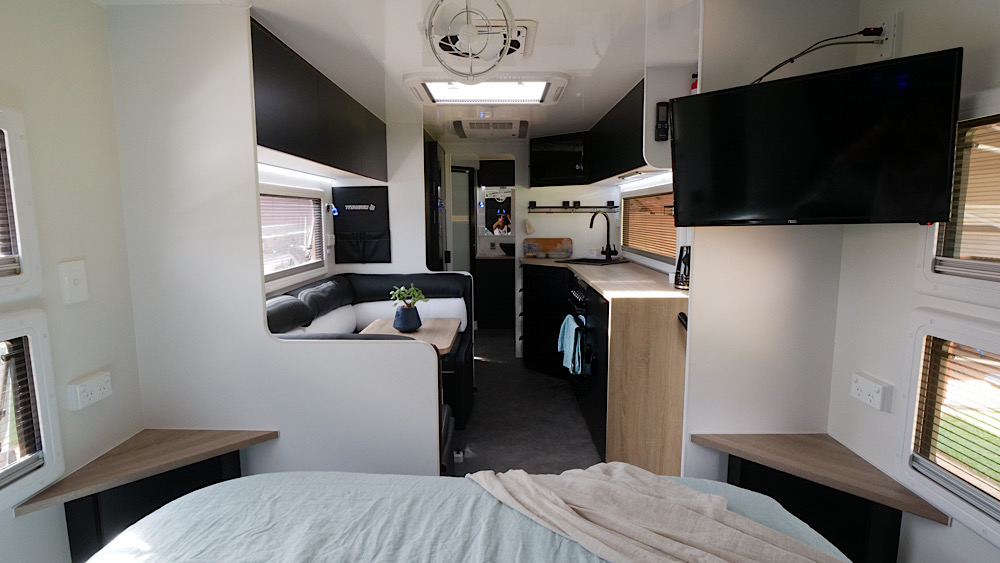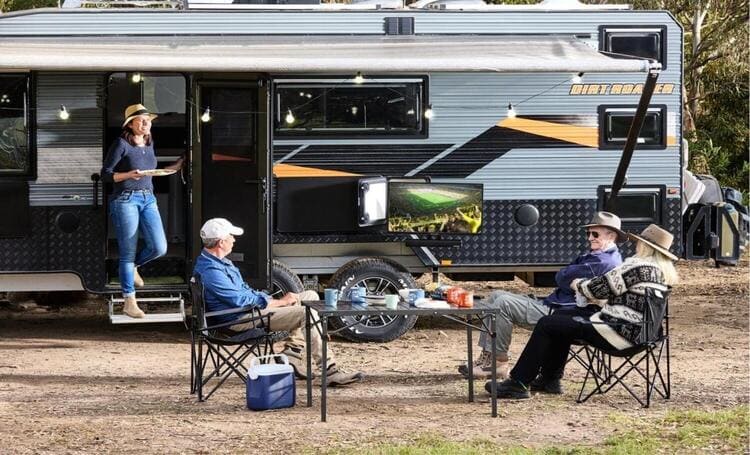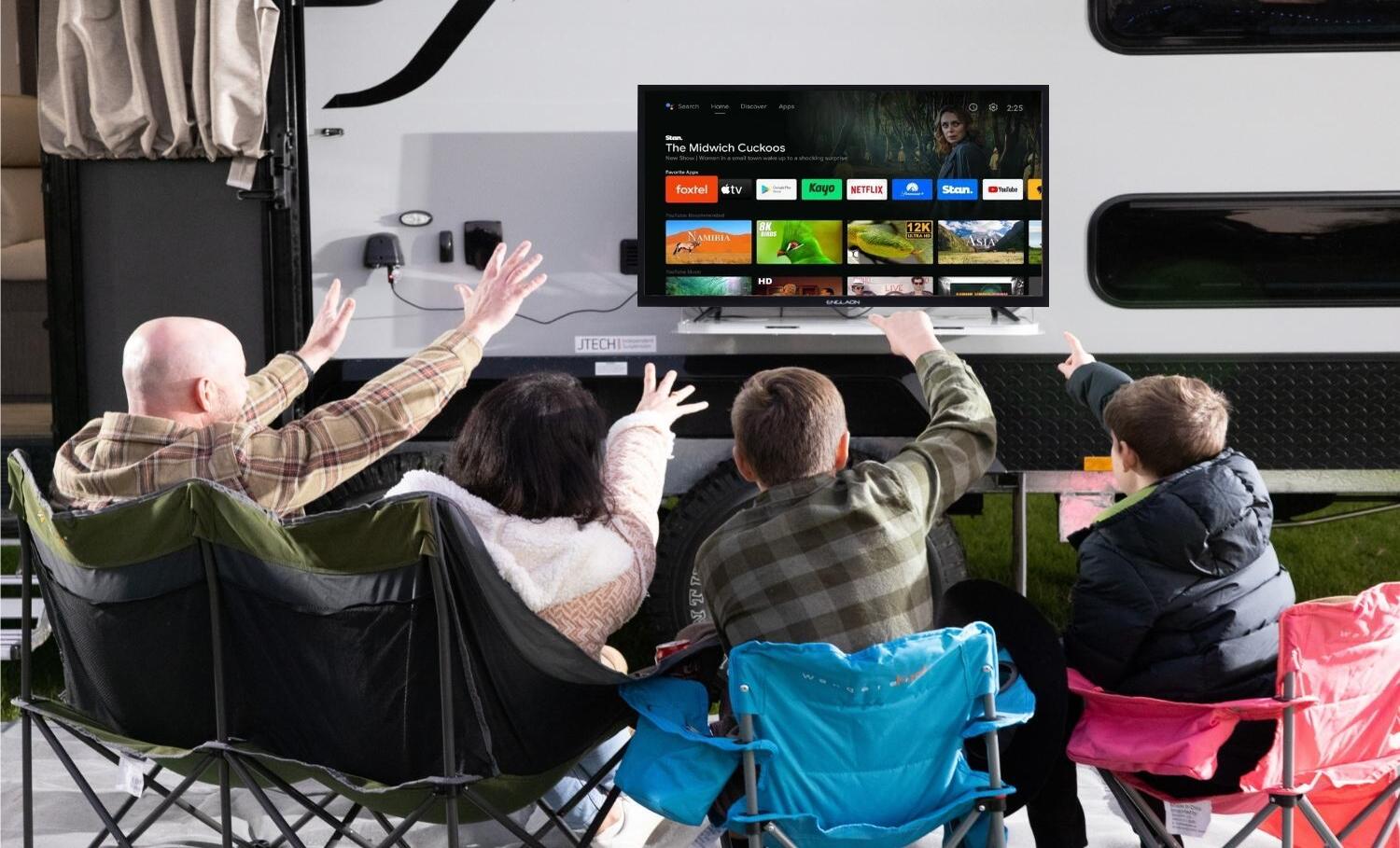Choosing the right TV for your caravan can make all the difference in your on-the-road entertainment experience. Whether you're looking for the best 12V caravan TV in Australia for reliable viewing in remote locations or exploring smart 12V TVs for caravans to stream your favorite shows, this guide will help you make the perfect choice.
Table Of Contents
- From Analog to Smart Systems: The Evolution of 12V Caravan TVs
- Power Dynamics: Choosing the Right Voltage for Your Caravan TV
- Display Technologies: HD vs FHD and Visibility in Daylight
- Installation & Integration: Setting Up Your Caravan TV
- Power Management: Efficient TV Operation in a Caravan
- Streaming & Connectivity: Staying Entertained Off-Grid
- Comparing Brands: Finding the Best 12V Caravan TV
- Maintenance & Troubleshooting Your Caravan TV
- Software Optimisation
- Emerging Technologies: The Next Generation of Caravan TVs
- FAQs About Caravan TVs:
- Finding the Perfect Caravan TV for Your Adventures
From Analog to Smart Systems: The Evolution of 12V Caravan TVs
The journey of 12V caravan TVs in Australia has come a long way, transitioning from basic analog receivers to feature-rich smart 12V TVs for caravans. In the early days, caravan TVs relied on analog signals, requiring bulky external antennas to pick up limited free-to-air channels. Reception was often unreliable, particularly in remote areas, leading to frustration for travellers seeking entertainment on the road.
With the switch to digital broadcasting, 12V caravan TVs began offering clearer picture quality, improved reception, and built-in tuners that eliminated the need for external set-top boxes. However, the biggest leap has come with the integration of Android and Google TV platforms, transforming caravan entertainment into a fully connected experience. These smart TVs allow users to stream Netflix, YouTube, and other apps directly, just like at home.
The impact of 4G and 5G networks has further revolutionised caravan TV usage, making it easier than ever to stream high-definition content even in remote areas. Travellers can now connect their smart TVs to mobile hotspots or dedicated caravan internet solutions, enjoying smooth, buffer-free streaming wherever they go. With these advancements, modern 12V caravan TVs offer an unparalleled level of convenience, ensuring that adventure-seekers never miss their favourite shows while exploring Australia’s great outdoors.
Power Dynamics: Choosing the Right Voltage for Your Caravan TV
When selecting a 12V caravan TV in Australia, understanding power requirements is essential. Caravan TVs typically come in 12V, 24V, or 240V variants, each with its own conversion needs and efficiency factors.
-
12V TVs are the most common choice for caravans, as they can run directly off the caravan’s battery system without the need for an inverter.
-
24V TVs are suited for larger motorhomes and trucks but often require a step-down converter for compatibility with 12V systems.
-
240V TVs are designed for home use and require an inverter to function in a caravan setup, which leads to efficiency losses due to energy conversion.
Case Study: Power Consumption Comparison
Efficiency is a key factor when choosing a caravan TV, as energy usage directly affects battery life. Comparing two popular models:
-
Englaon X70 Series: Uses 48W max consumption, offering a feature-rich experience but drawing more power.
-
Aussie Traveller 12V TV: Consumes only 36W, making it a more energy-efficient option for off-grid travellers.
For those relying on solar or battery power, opting for a lower-wattage model can significantly extend viewing time without draining resources.
Display Technologies: HD vs FHD and Visibility in Daylight
When it comes to screen quality, HD (720p) and Full HD (1080p) displays dominate the compact TV market. While FHD provides sharper visuals, the difference may not always be noticeable on smaller caravan TV screens (19”–24”). More important factors include viewing angles and daylight visibility.
-
HD (720p): More power-efficient, suitable for smaller screens.
-
Full HD (1080p): Better for larger caravan TVs, offering crisper details.
Anti-Glare Coatings for Outback Conditions
Outdoor and off-grid caravanners often deal with excessive sunlight, which can cause screen reflections and reduced visibility. High-end smart 12V TVs for caravans now feature anti-glare coatings and higher brightness displays, improving visibility in daylight conditions, especially when traveling in Australia’s harsh outback.
Choosing the right 12V caravan TV means balancing power efficiency, screen clarity, and outdoor usability, ensuring a seamless entertainment experience on the road.
Installation & Integration: Setting Up Your Caravan TV
Mounting Solutions: Choosing the Right Setup
Proper installation of your 12V caravan TV ensures both safety and convenience while travelling. The right mounting solution depends on your caravan’s layout and how you plan to use the TV.
-
VESA Compatibility: Most 12V TVs for caravans come with standard VESA mount patterns (e.g., 75x75mm, 100x100mm or 200x100mm), making them compatible with a range of wall brackets.
-
Swivel vs Fixed Brackets:
-
Swivel Brackets: Ideal for multi-angle viewing, allowing you to adjust the screen based on seating or bed placement.
-
Fixed Brackets: More secure for travel, preventing movement and reducing strain on mounting points.
-
Vibration Damping for Corrugated Roads
Rough terrain, especially corrugated outback roads, can cause excessive vibrations that may damage the TV or loosen mounting brackets. To minimise this:
-
Use rubber bushings or shock-absorbing mounts to minimise vibration impact.
-
Secure the TV with travel locks or quick-release straps when in motion.
-
Opt for reinforced wall mounts designed for RV and caravan use.
Power Management: Efficient TV Operation in a Caravan
A reliable power setup is crucial for running a 12V caravan TV without draining essential energy reserves. Many caravans use a dual-battery system, consisting of:
-
Starter Battery – Powers the vehicle.
-
House (Deep Cycle) Battery – Runs appliances like the TV, fridge, and lights.
A properly wired TV circuit should be connected to the house battery with:
-
An inline fuse (5A-10A) to protect the TV.
-
A DC-DC charger or battery management system (BMS) to regulate voltage.
Solar Integration: Running a Caravan TV 24/7
For off-grid travellers, solar power is an efficient way to keep your TV running. The size of the solar panel system depends on the TV’s power draw. Example Calculation:
-
TV Power Consumption: 40W (on average).
-
Daily Usage: 5 hours = 200Wh/day.
-
Solar Panel Sizing:
-
A 200W solar panel generates approx. 800Wh per day in good sunlight conditions, easily covering the TV’s energy needs plus extra for other appliances.
-
A 100Ah lithium battery stores enough energy to run a 12V smart TV overnight.
-
Streaming & Connectivity: Staying Entertained Off-Grid
With the rise of smart 12V TVs for caravans, streaming services like Netflix, YouTube, and Stan have become essential for travellers. However, accessing reliable internet in remote areas can be challenging. Two primary solutions are RV Wi-Fi Routers and Starlink, each with distinct benefits.
RV Wi-Fi Router vs Starlink: Cost & Performance Comparison
|
Feature |
RV Wi-Fi Booster |
Starlink Roam (Mobile) |
|
Function |
Amplifies existing cellular signal (4G/5G) |
Satellite-based broadband internet |
|
Coverage |
Dependent on mobile tower proximity |
Available anywhere with a clear sky view |
|
Speed |
10-100 Mbps (varies by reception) |
50-150 Mbps (consistent) |
| Latency | Low (~30ms) | Higher (~50ms) |
|
Cost (AU) |
$300-$800 (one-time) Cost of pre-paid sim card |
$450 hardware + $174/month subscription |
|
Best For |
Travellers near populated areas with mobile coverage |
Remote-area campers needing reliable, high-speed internet |
For those staying closer to towns and highways, a Wi-Fi booster or 4G/5G mobile router is a cost-effective choice. However, for full off-grid reliability, Starlink Roam is currently the best satellite internet option.
Data-Saving Strategies for Netflix Streaming
Streaming can consume large amounts of data, but a few strategies can help stretch your mobile plan:
-
Lower Streaming Quality:
-
Netflix: Set to Standard Definition (SD) (uses ~1GB per hour) instead of HD (3GB/hr).
-
-
Download Content in Advance: If heading off-grid, download shows/movies when connected to free Wi-Fi.
-
Use Mobile Hotspot Smartly: Limit other devices connected to your mobile hotspot to prevent unnecessary data usage.
-
Limit Background Apps and Devices: Close other apps that might also use data while you're streaming and limit devices running at the same time.
Antenna Systems: Getting the Best Reception
For those who prefer free-to-air channels over streaming, choosing the right TV antenna system is crucial. Lets compare directional vs Omnidirectional Antennas.
|
Feature |
Directional Antenna |
Omnidirectional Antenna |
|
How It Works |
Must be manually pointed towards the nearest broadcast tower |
Receives signals from all directions automatically |
|
Signal Strength |
Stronger in targeted areas |
Weaker but more versatile |
|
Best Use Case |
Staying in one location for extended periods |
Frequent travellers who move often |
|
Example Models |
Winegard Sensar |
King Jack Omni |
Signal Strength Mapping Across Australia:
-
Best for Coastal & Urban Areas: Omnidirectional antennas work well due to denser signal coverage.
-
Best for Regional & Remote Areas: Directional antennas provide better range but require manual adjustment.
For caravanners who often travel through remote regions, a satellite TV system (VAST) ensures access to national broadcasts anywhere. Meanwhile, those staying closer to towns and coastal areas may find a high-quality digital antenna sufficient.
By combining the right internet solution, data-saving strategies, and a reliable antenna system, caravanners can enjoy uninterrupted entertainment, no matter where their journey takes them.
Comparing Brands: Finding the Best 12V Caravan TV
When choosing the best 12V caravan TV in Australia, brand reputation and real-world performance matter. Leading brands in the space, Englaon, Sphere, RV Media and Aussie Traveller, offer unique features catering to different caravan setups.
Englaon: Smart Features vs Durability
Englaon is known for its high-tech smart 12V TVs for caravans, offering seamless entertainment integration. The X70 Series is one of its flagship models, featuring:
-
Android TV OS: Access to Netflix, YouTube, and other apps.
-
Google Assistant & Chromecast: Hands-free control and content casting from mobile devices.
-
Bluetooth & Wi-Fi Connectivity: Enables easy pairing with external speakers and mobile hotspots.
Frameless Durability: Is It Road-Ready?
Englaon’s frameless designs offer a sleek look but raise questions about durability. Compared to traditional framed TVs, frameless screens can be more vulnerable to vibrations and impact when traveling on rough terrain.
Aussie Traveller: Rugged Simplicity with Smart OS Benefits
Aussie Traveller TVs focus on durability and user-friendly functionality, making them a great option for caravanners who prioritise reliability over extra features.
Unlike Android TV, Aussie Traveller’s VIDAA OS is a lightweight smart TV system optimised for quick app access and lower power consumption. Benefits include:
-
Faster boot times than Android TVs.
-
Pre-installed streaming apps (Netflix, YouTube, Prime Video) with minimal bloatware.
-
More energy-efficient operation, making it ideal for off-grid setups.
Built-in DVD Player: Longevity in Dusty Conditions
For travellers exploring red-dirt regions like the Outback, built-in DVD players often struggle due to dust ingress. Aussie Traveller TVs use sealed drive mechanisms to prevent premature wear, making them more reliable in harsh environments. However, if dust buildup is a concern, using an external media player or streaming device might be a better long-term solution
Final Thoughts: Which Brand is Best for You?
For those who love smart streaming and voice controls, Englaon’s X70 Series is the way to go. However, if durability and reliability in harsh conditions are top priorities, Aussie Traveller offers a solid, no-fuss option for caravanners exploring Australia's toughest terrains.
Maintenance & Troubleshooting Your Caravan TV
Proper maintenance and troubleshooting can extend the life of your 12V caravan TV and ensure smooth operation in various conditions. From extreme weather protection to software fixes, here’s how to keep your caravan entertainment system running optimally.
Weather Operating Thresholds: Performance from -5°C to 45°C
Most smart 12V TVs for caravans are designed to function within a temperature range of -5°C to 45°C. However, real-world performance may vary:
|
Temperature |
Effects on Caravan TV |
Preventive Measures |
|
Below 0°C |
LCD panels may slow down, risk of condensation inside unit |
Keep TV inside caravan when not in use, avoid powering on a frozen screen |
|
35°C – 45°C |
Overheating may cause auto shutdown, Wi-Fi issues, and screen discoloration |
Ensure proper ventilation, avoid placing TV in direct sunlight |
|
Above 45°C |
Permanent damage to circuits, increased risk of screen burn-in |
Use reflective window covers in hot climates, switch off TV when not in use |
Pro Tip: If travelling in extreme heat, consider placing a USB-powered cooling fan near the TV for improved airflow.
Condensation Prevention During Coastal Trips
Caravanners exploring beachside locations may experience moisture buildup inside their TV, leading to screen flickering or internal corrosion. To prevent this:
-
Use silica gel packs or dehumidifiers inside the caravan.
-
Store the TV in a dry, well-ventilated area when not in use.
-
After exposure to salty air, wipe the screen and vents with a microfiber cloth to remove residue.
Software Optimisation
Updating firmware is essential for keeping smart 12V TVs for caravans running smoothly, but what if you're off-grid with limited internet access?
For brands like Englaon, offline firmware updates can be performed via USB drive:
-
Download the latest firmware file from the manufacturer’s website using a stable internet connection (before your trip).
-
Transfer the file onto a USB drive formatted in FAT32.
-
Insert the USB into the TV and navigate to Settings > Software Update > USB Update.
-
Follow on-screen instructions and restart the TV after the update completes.
By preparing firmware updates in advance, caravanners can avoid performance issues without relying on internet connectivity.
Resolving Errors on Englaon Units
One common issue Englaon users report is the “Database Empty” error, where the TV fails to detect channels. Here’s how to fix it:
-
Check Antenna Connection: Ensure the coaxial cable is firmly connected and the antenna is properly positioned.
-
Perform a Full Auto Scan:
-
Go to Menu > Channel Setup > Auto Scan and let the TV rescan for channels.
-
-
Switch Between Antenna & Cable Mode:
-
In some cases, the TV may be set to Cable Mode instead of Antenna Mode.
-
Navigate to Settings > Tuner Mode > Select Antenna and rescan.
-
-
Reset TV to Factory Settings:
-
If all else fails, go to Settings > System > Restore Default Settings and try rescanning.
-
By following these steps, travellers can quickly restore free-to-air channels without needing external assistance.
By maintaining your 12V caravan TV with proper weather protection, regular software updates, and troubleshooting common issues, you can enjoy a hassle-free entertainment experience—no matter where the road takes you!
Emerging Technologies: The Next Generation of Caravan TVs
With the rise of Starlink and other low-Earth orbit satellites, future smart 12V TVs for caravans could integrate direct satellite connectivity, eliminating the need for antennas or mobile networks.
How This Could Change Caravan Entertainment:
-
Seamless Streaming Anywhere – Unlike traditional satellite TV (which requires a dish), built-in LEO satellite receivers could provide instant access to streaming platforms and live TV, even in remote areas.
-
No Need for Wi-Fi Boosters – With direct satellite connectivity, travellers wouldn’t need to rely on cellular networks or expensive mobile data plans.
-
Better Reliability in Harsh Conditions – LEO satellites provide stronger signals in remote and rugged environments where traditional antennas struggle.
While this technology is still in development, Starlink’s ongoing expansion suggests that integrated satellite-to-TV connections may become a reality within the next few years.
FAQs About Caravan TVs:
What is the best 12V caravan TV in Australia?
The best 12V caravan TV depends on your needs. Englaon X70 Series offers smart features with Android TV and Chromecast, while Aussie Traveller TVs provide rugged durability and a built-in DVD player for dusty conditions.
Can I watch Netflix and YouTube on a caravan TV?
Yes! Many smart 12V TVs for caravans come with built-in Wi-Fi and pre-installed apps like Netflix, YouTube, and Prime Video. If your TV isn’t smart, you can use a streaming device (Chromecast, Fire Stick, or Apple TV) with a Wi-Fi connection.
How much power does a caravan TV use?
Most 12V caravan TVs consume between 20W and 50W, depending on screen size and features. For example:
-
Englaon X70 Series: 48W max power draw
-
Aussie Traveller 24” TV: 36W max power draw
If running off solar, ensure your system can handle the caravan TV power draw along with other appliances.
Will my caravan TV work off-grid?
Yes, but you need a reliable power source. A solar-powered battery system with at least 100Ah capacity is recommended for extended off-grid use. For streaming, consider RV Wi-Fi boosters or Starlink for better 4G streaming in the outback.
How do I install a TV in my caravan?
Most 12V TVs support VESA mounting brackets for secure installation. Choose between:
-
Fixed brackets (best for stable positioning)
-
Swivel brackets (for flexible viewing angles)
To prevent damage from rough roads, ensure the mount includes caravan TV vibration proofing, such as shock-absorbing pads or rubberized brackets.
Can I use a home TV in my caravan?
A 240V home TV is not ideal for caravan use because:
-
It requires an inverter, causing power loss.
-
It lacks vibration resistance, making it more prone to damage on rough roads.
A dedicated 12V caravan TV is built for power efficiency, durability, and travel-friendly features.
Finding the Perfect Caravan TV for Your Adventures
Choosing the right 12V caravan TV requires balancing power efficiency, connectivity, and durability to match your travel style. Whether you’re prioritising low power draw for off-grid use, ensuring seamless 4G streaming outback, or selecting a model with vibration proofing for rough roads, the best option depends on your specific needs. With innovations like smart streaming platforms and satellite integration, the future of caravan entertainment is brighter than ever. By considering the right display technology, mounting solutions, and connectivity options, you can enjoy a reliable and immersive viewing experience—wherever the open road takes you!
Got questions? Feel free to reach out to our friendly team or check out our range of Caravan TVs here.
-
DISCLAIMER* Please note, this advice is general in nature and we strongly recommend consulting the product manual and where relevant, a professional installer.
Comments (16)
Selecting a station from the EPG
Do any of the 12 v tvs allow you to select the tv station you want by clicking on the EPG like most home tvs. All I have seen make you close the EPG and then you have to manually change to the station you want. SteveBy: Steve Scott on 21 March 2025
www.caravanrvcamping.com.au Response
Hi Steve, The range of Englaon TV's have the ability to show the channels, whilst it won't show the TV guide on what is available to watch it will be easier to select channels.
Help
I have a hybrid in which I spend most of my camping time off-grid. I want to watch AFL football as I travel mainly in the winter months. I'm not interested in movies, YouTube , emails or anything else. Can you list everything I require, right down to model name and number. The TV screen size does not need to be large. Just large enough for two people.By: Steve on 15 January 2025
www.caravanrvcamping.com.au Response
Hi Steve, there is nothing better than sitting around a fire in winter watching football. At the moment Kayo isn't currently available through their App on most caravan TV's. So choosing a caravan TV that has Chrome-casting ability means you can have it on your phone playing and cast it up to the TV for your viewing pleasure.
12V TV that can operate down to say 11V.
Hi guys, I have an issue where I watch TV using Starlink for internet service when off grid. Starlink is powered by an inverter and can use a bit of battery power. I notice that as soon as my battery charge draws down to 12v, the TV starts playing up i.e. is doesn't like operating on anything less than 12V supply. Can your TV's operate at less (e.g. 11V)? A generator is one answer and I have one but in busy campsites, it's not always the best option after 8pm.By: Trevor Epding on 08 October 2024
www.caravanrvcamping.com.au Response
Hi Trevor, the 12v TV's really do like a nice healthy battery to operate. An option I would look at considering is changing the way you power your Starlink and check out the RV Wifi Dishy Dock system. This connects to your 12v battery systems and negates the need for your inverter. Please give us a call on 1800 787 278 and we can discuss this option for you.
Hot spot from iphone
Hi this question has probably been asked before. I am chasing a smart 12v tv I can hot spot my iPhone too to watch Netflix, Kayo, etc. Don’t want to pay the high price of wifi plans as we are only occasional weekend traveller. What tv would you recommend I purchase. Thanks in advanceBy: Dave Belford on 25 April 2024
www.caravanrvcamping.com.au Response
Hi Dave, from what I understand the Apple Watch doesn't offer a hot spot function. You can certainly hot spot your mobile phone to any of our smart TV's. Choosing the TV would be based on the space you have to mount the tv, whether you want added extras such as a DVD player or Bluetooth. All these options are available on our website and we are here on LIVE Chat, email or phone in business hours. Please don't hesitate to reach out


.jpg)

.jpg)
(1).jpg)
.jpg)
.jpg)





